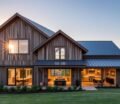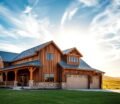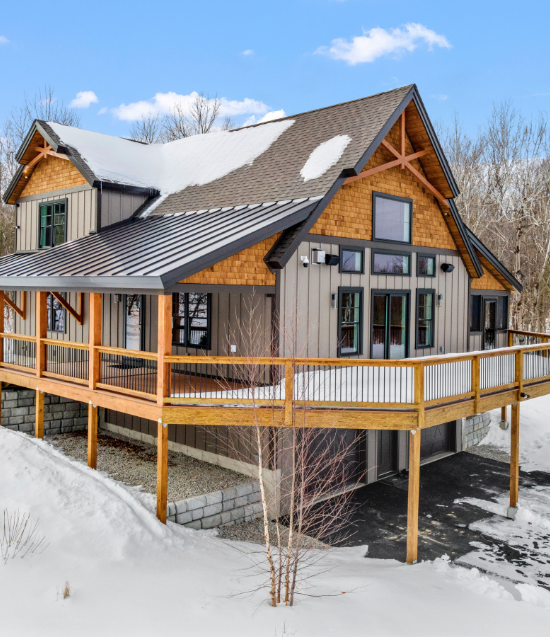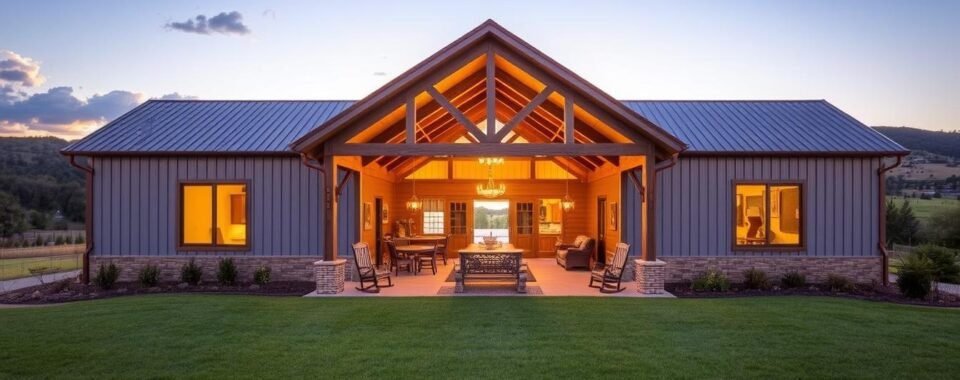

We remember walking a three-acre plot outside Austin. A contractor from General Steel showed us a kit frame rising from the dirt. In a few weeks, the shell would be ready — a strong structure that combines a workshop and a cozy living room.
This moment showed us why Texas Barndominiums are changing how we build. They offer speed, durability, and the chance to have both home and work under one roof.
Steel suppliers like General Steel and Capital Steel Industries provide turnkey kits. These kits let builders close the shell fast — often in about four weeks. They also offer clear savings compared to traditional building methods.
For investors and owner-builders, this means lower costs and plans that can be repeated. These plans work well for build-to-rent or spec projects.
Market figures show shell pricing at about $65–$150 per square foot. Regional finish-cost averages vary: Northeast $170–$240, West $180–$260, Midwest $150–$190, and Deep South $160–$210. Luxury turnkey projects in coastal metros can cost over $400 per square foot (Barndoguru 2025; HomeGuide 2025).
These cost estimates explain why developers watch Barndominium construction companies in Texas closely. They also show why Texas metal buildings are key to the trend.
If you’re looking at builders, designs, or budget models, we can help. Reach out at info@barndoplans.com or call +1-844-963-9963. We can discuss planning, quotes, or local Barndominium construction companies in Texas.
What is a Barndominium?
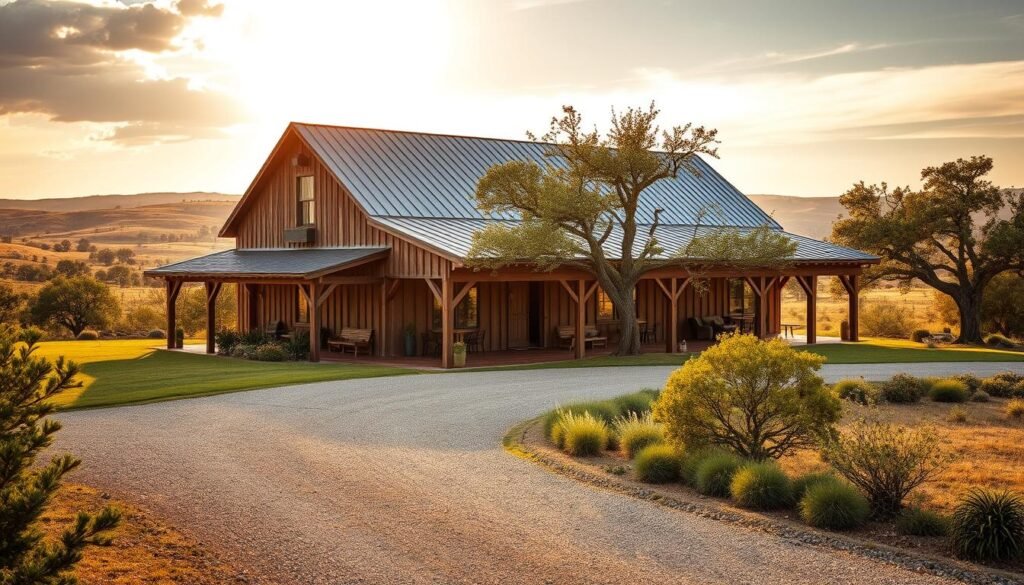
A barndominium is a mix of a barn and a home. It started as a way for ranchers in Texas to live and work in one place. This idea became popular after TV shows featured it around 2016.
Definition and Origin
A barndominium, or barndo, is a home built from a barn or designed to look like one. Early ones were old barns turned into homes. Now, they are built to be homes that look like barns but meet today’s standards.
It all started in Texas, where ranchers needed a place to live and work. This idea became a popular choice for its durability and easy upkeep. Companies like General Steel and Capital Steel Industries helped make these homes more available.
Key Features
Barndominiums are known for their simple design. They have open spaces for big rooms and flexible upper levels. They use steel frames that are easy to put together.
They come in different sizes, from 30×40 to 60×70. This allows for many different layouts, like homes with shops or living areas upstairs.
They use insulation like batts and metal panels. Some builders warn against using spray foam in certain situations. The steel outside is easy to take care of and keeps out pests and fire. Inside, they use wood, windows, and doors to make it cozy.
| Feature | Why it Matters | Typical Expression |
|---|---|---|
| Open-span bays | Creates versatile interior space for living, storage, or workshop | Wide living rooms, vehicle bays, unobstructed shop floors |
| Pre-engineered steel | Speeds construction, improves durability and precision | Bolt-together frames from General Steel or Capital Steel Industries |
| Roof options | Influences light, ventilation, and loft space | Monitor roofs for clerestory light, gable roofs for classic look |
| Insulation & finishes | Affects energy use and comfort inside | Batt insulation, insulated panels, wood trim, quality windows |
| Typical kit sizes | Determines the size of the living area and shop | 30×40, 40×60, 40×75, 60×60, 60×70 |
| Benefits | Less upkeep outside, saves on utilities, strong structure | Resists termites, low upkeep, efficient heating and cooling |
Popular Design Trends for Texas Barndominiums
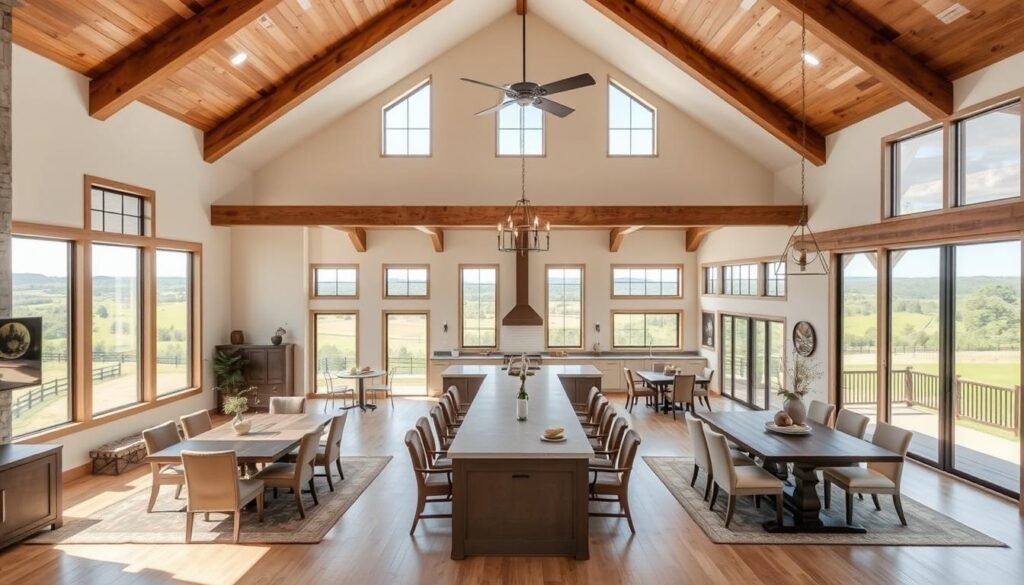
We look at three design trends for Texas Barndominiums: open, rustic, and contemporary. Each trend uses steel framing’s flexibility. Owners can customize interiors with smart choices in Barndominium floor plans and finishes.
Open Floor Plans
The large clearspan bays of Texas metal buildings create cathedral-like volumes. These are perfect for open living. Great rooms, mezzanines, and vaulted ceilings make flexible spaces for family gatherings or workshops.
Designers use 3D renderings and virtual staging to show how spaces work. Kitchens flow into dining nooks, lofted offices overlook living areas, and garage-to-studio transitions are possible. These tools help refine Barndominium floor plans before construction starts.
Rustic Elements
Rural buyers love reclaimed timbers, wide-plank wood floors, and sliding barn doors. These elements capture a classic barn look while keeping metal framing’s resilience. Exposed steel trusses and monitor roofs preserve the agricultural feel without losing performance.
Brands like General Steel say mixing wood accents with steel structures meets aesthetic and durability goals. Many owners add large porches and insulated barn doors. These features enhance indoor-outdoor living and comfort through the seasons.
Modern Finishes
Contemporary kitchens, spa-like baths, and luxury fixtures make some projects cost like traditional homes. Concrete countertops, large-format tile, and glass partitions create an industrial-rustic palette. This is prized in luxury Barndominiums.
Turnkey luxury builds can cost over $400 per square foot in some markets. To save money, owners mix pre-engineered kits with owner-finish interiors. This way, they can keep workshop space or offices for later.
For real examples of these elements in action, check out a detailed overview on design options and interior living quarters in metal homes at Barndominium design and living.
| Design Element | Typical Features | Benefit |
|---|---|---|
| Open Layouts | Vaulted ceilings, mezzanines, flexible great rooms | Maximizes usable volume and natural light |
| Rustic Details | Reclaimed wood, exposed trusses, barn doors | Preserves traditional aesthetic with durable materials |
| Modern Finishes | Concrete counters, large tile, glass partitions | Delivers high-end look and easy maintenance |
| Customization | Pre-engineered kits, varied roof styles, owner-finish options | Allows phased builds and budget flexibility |
| Lifestyle Integration | Large porches, workshop access, indoor-outdoor flow | Supports hobby spaces and rural living needs |
Benefits of Living in a Barndominium
Barndominiums are a smart mix of space, strength, and design. They fit well in both rural and suburban areas. Here are the top reasons why they’re a great choice for homeowners.
Affordability
Steel shell kits cost between $40–$65 per square foot. For a 2,000 sq ft home, this is cheaper than traditional homes. It saves money for interior work or other needs.
Energy Efficiency
Barndominiums can save 30–50% on electricity. The right insulation and air sealing are key. This ensures energy savings for homeowners.
Customization Options
Steel kits offer quick building and flexibility. You can design your space without waiting. This makes it easy to create a home that fits your needs.
Maintenance and Insurance
Steel homes need little upkeep. They’re also safer from pests and fires. This can lower insurance and maintenance costs over time.
Speed-to-Occupancy
Steel shells can be ready in just four weeks. This fast setup saves time and money. It’s perfect for those who want to move in quickly.
We suggest getting different cost estimates for Barndominiums. Talk to experienced builders to plan your project. This way, you can compare options and make the best choice for your budget and needs.
Choosing the Right Builder for Your Barndominium
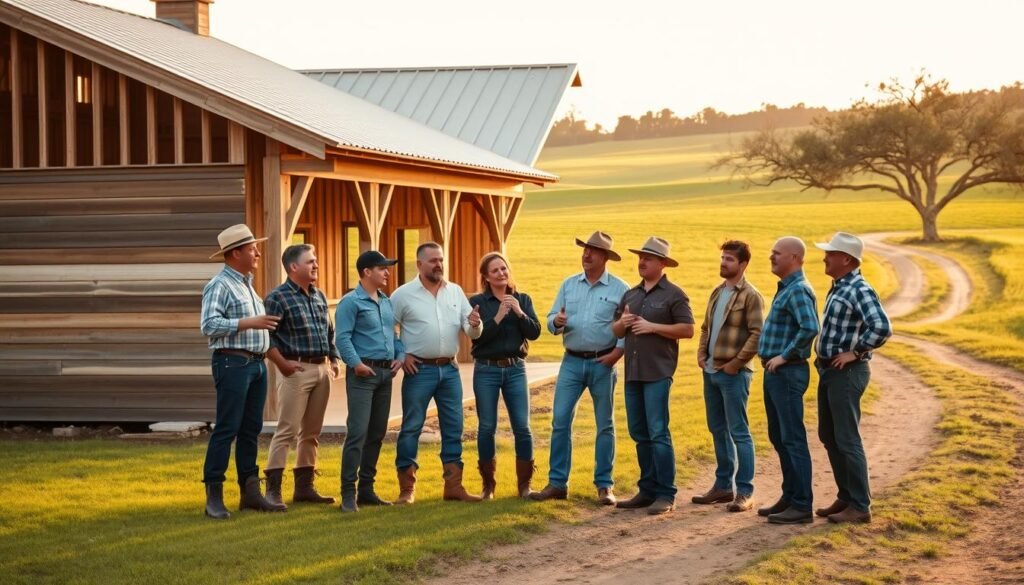
We help teams and individuals find the best builder for their barndominium. The right builder affects the project’s timing, cost, and quality. It’s important to look for experience with local codes and steel kits, along with good craftsmanship.
Questions to Ask Potencial Builders
First, ask for detailed plans and manufacturer warranties. Get fixed-price quotes that show costs for foundation, erection, and interior work. Make sure they have a clear schedule for shell delivery and erection.
Check if they have experience with pre-engineered steel kits and which brands they use. Also, ask about their risk management, like milestone-based contracts and contingency funds. A 10% contingency is a good starting point for unexpected issues.
Evaluating Builder Portfolios
Look at their past projects for insulation, roof styles, and finish quality. Check for mixed-use designs and how they handle interior finishes. Projects that show both kit erection and interior work show a builder’s skill.
Look for detailed photos and notes on materials, insulation, and trim. This shows a builder’s focus on durability and comfort.
Importance of Local Expertise
Local knowledge is key for permits, codes, and subcontractors. Builders familiar with Texas can navigate zoning and building codes better. They also know wind, seismic, and energy codes specific to the area.
Working with builders who have partnerships with General Steel or Capital Steel can help. These relationships can make assembly faster and may get you discounts from suppliers.
| Decision Point | What to Ask or Review | Why It Matters |
|---|---|---|
| Engineered Plans & Warranties | Request stamped plans and manufacturer warranty documents | Ensures structural compliance and protects material quality |
| Fixed-Price Breakdown | Separate foundation, erection, interior trade costs | Improves cost transparency and reduces scope disputes |
| Kit Experience | Confirm brands handled and examples of 30×40–60×70 installs | Shows practical skills with pre-engineered steel systems |
| Portfolio Detail | Inspect insulation, roof style, finish quality, mixed-use work | Reveals attention to performance and aesthetic execution |
| Local Permitting | Ask about county zoning, masonry rules, wind/energy codes | Reduces permit delays and rework |
| Contract & Risk Terms | Look for milestone payments and contingency allowances (10%+) | Mitigates financial and schedule risk |
| Supply Chain Partners | Verify partnerships with General Steel, Capital Steel, or fabricators | Streamlines procurement and can lower material costs |
| Subcontractor Network | Request list of regular trades and references | Ensures reliable crews for steel erection and interior finishes |
We suggest talking to several Barndominium builders in Texas. Compare how custom and large builders handle schedule, scope, and warranties. This comparison helps you understand the value and fit for your project.
Cost Breakdown of Building a Barndominium
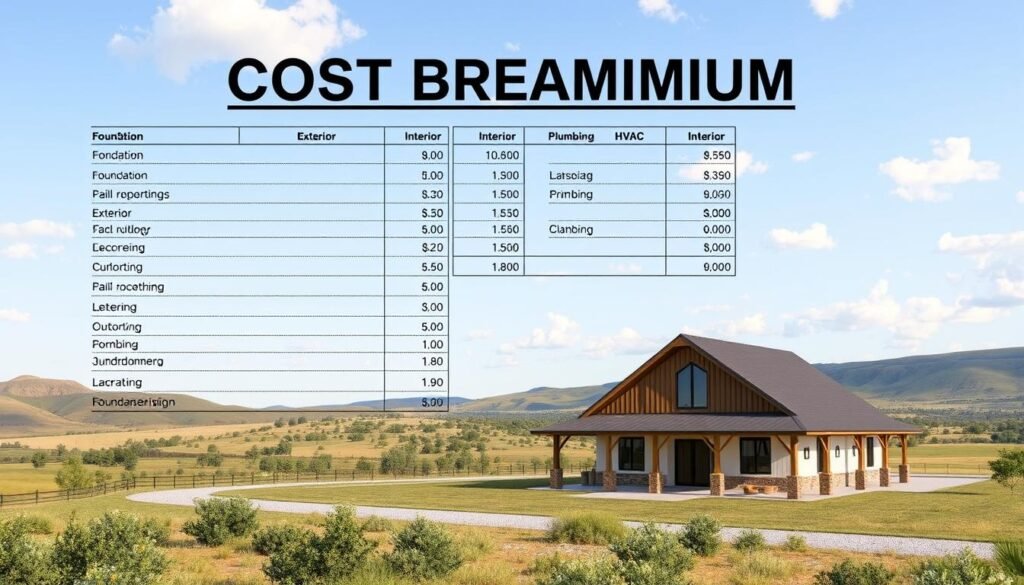
We break down the costs so teams and owners can plan well. Early budgeting helps shape design and timelines. We outline typical costs for materials, labor, and other expenses that might surprise builders.
Material Costs
Steel shell kits are the main cost: basic kits cost $40–$65 per sq ft. Higher-spec shells can cost $65–$150 per sq ft for better insulation and design.
Choosing materials quickly changes the cost. A simple steel shell is cheaper, while insulated panels and special roofs increase the price. In Texas, local suppliers affect prices and delivery times.
Labor Expenses
Putting the building together costs about $10–$16 per sq ft. Adding a concrete foundation or slab costs $6–$10 per sq ft. Finishing the inside can cost $50–$140 per sq ft, depending on the level of finish and complexity.
Union labor, local demand, and specialized trades like HVAC or plumbing can raise costs. Barndominium companies in Texas often give bundled estimates to manage costs.
Hidden Costs to Consider
Don’t forget about permits, zoning fees, and impact assessments. Costs can go up for elevated slabs in flood zones, extended utility runs, and special HVAC for large spaces.
Upgrading the roof or insulation, like spray foam, can also increase costs. Plan for unexpected price changes and delivery delays.
Managing costs is possible. Consider building in phases, ordering kits in bulk, and using virtual renderings to sell or lease space. These strategies help control costs and refine estimates before starting.
| Component | Typical Range (per sq ft) | Notes |
|---|---|---|
| Building system (steel shell) | $12–$18 | General system cost excluding cladding and insulation |
| Basic shell kit | $40–$65 | Bare steel; regional variations apply for Texas metal buildings |
| High-spec structural shell | $65–$150 | Insulated panels, architectural cladding, monitor roofs raise price |
| Building erection (labor) | $10–$16 | Crane, crew, and on-site assembly |
| Concrete foundation | $6–$10 | Site prep and local soil conditions affect cost |
| Interior finish (labor & materials) | $50–$140 | Range covers basic to high-end finishes and MEP systems |
| Permits & site-specific fees | Varies | Municipal fees and special inspections can be significant |
| Utility extensions (septic, well, electric) | Varies | Remote sites raise costs; coordinate with local providers |
| Contingency for material price volatility | 5–10% of budget | Protects against steel and fuel price swings |
Financing Options for Barndominiums
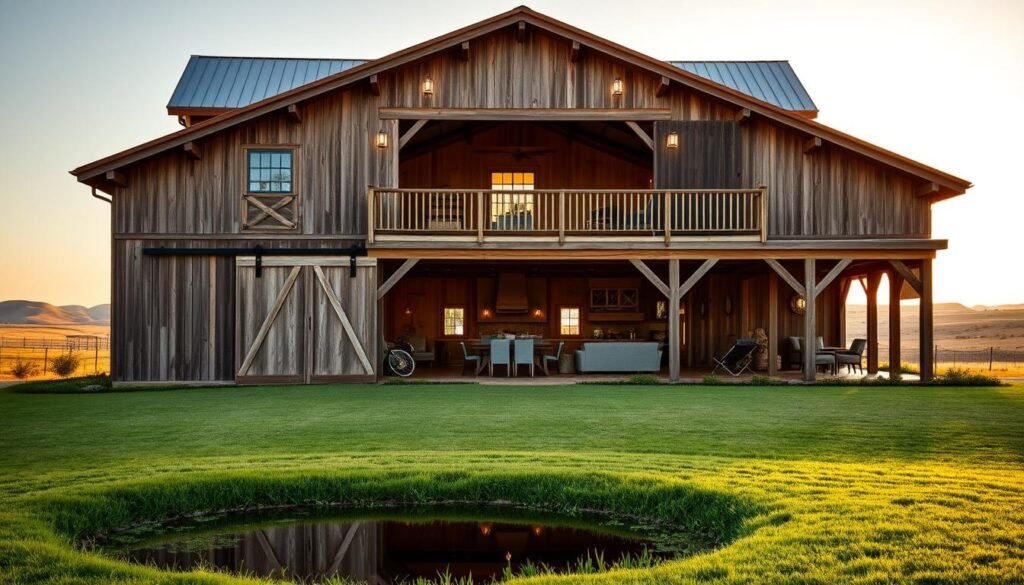
We help builders, owners, and developers find the best financing for Texas projects. The right loan can affect your timeline, budget, and risk. We’ll show you common paths and tips to get approved and keep your project profitable.
Traditional Loans
Construction-to-permanent loans are the most popular choice. They turn into a mortgage after the build is done. You’ll need a down payment of 5–20%.
In 2025, conventional rates are around 6–7%. FHA 203(k) loans help with renovations and need only a 3.5% down payment. VA loans offer 0% down for veterans.
Lenders want engineered plans, warranties, and a detailed build schedule. Adding pre-construction appraisals and professional designs can help with community banks.
Alternative Financing Solutions
USDA One-Time Close loans offer 0% down and up to 100% LTV for rural areas. This is great for owner-occupants in remote Texas counties. Specialty lenders like Rural 1st offer flexible draw schedules and can finance prefab steel with a 15% down payment.
Developers can save by ordering in bulk and getting vendor discounts. Lenders look for clear agreements, warranties, and a solid plan.
Managing risk is key. Keep at least 10% for contingencies due to steel price changes. Lock in interest rates 60 days before steel delivery to avoid penalties.
Insurance and lender views on mixed-use plans vary. They might see them as light-commercial. Check early to avoid issues with premiums and loan approval. Working with local Barndominium builders in Texas can help with these details and cost estimates.
Key Considerations Before Building
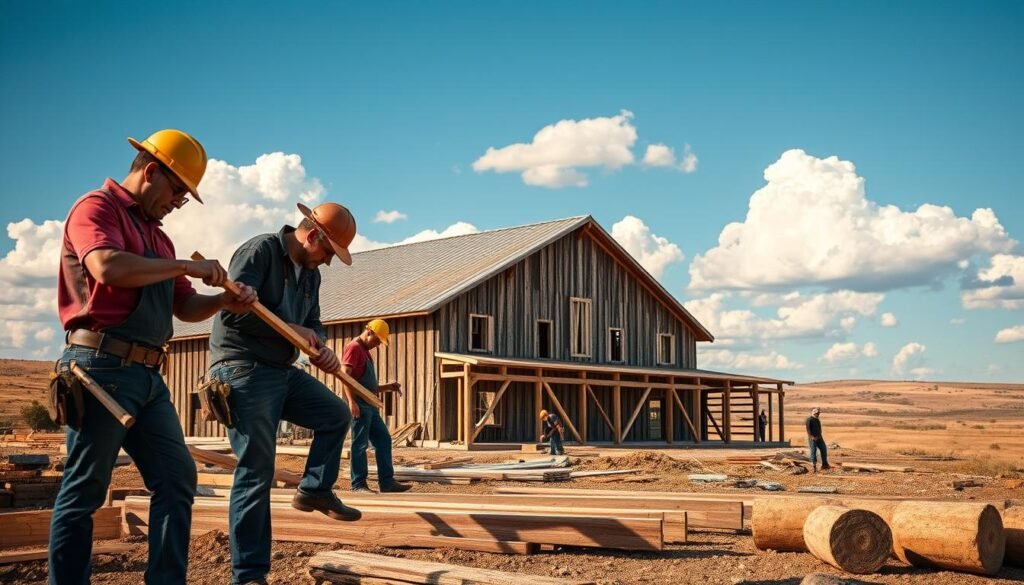
Before we start building, we look at the site, local rules, and what utilities are needed. Making smart choices here affects the cost, timeline, and how well the project will last. This is true for any project using Texas metal buildings or following common Barndominium floor plans.
Land Selection
We check zoning, flood maps, access, and soil conditions first. Zoning can limit what you can do or require certain distances. If the land is in a flood zone, you might need to raise the slab, which can save a lot of money.
Being close to utilities is important because long distances add to the cost. If the land is far away, it will cost more to get there. A geotechnical report can help find problems that affect the foundation and its cost.
Local Building Codes
Building permits have different rules in each area. Some places don’t allow metal siding on homes or require more masonry. Energy codes, wind loads, and seismic requirements also affect the design and materials used.
It’s wise to hire Barndominium builders in Texas who know the local rules. They can help avoid delays and extra work.
Utilities and Necessities
Plan for septic, wells, or city water. You might need to upgrade the electrical service for things like HVAC, shop equipment, or electric cars. These things affect the cost and when things need to be done.
Choose the right insulation and HVAC for Texas’s weather. Spray foam or insulated panels work better than batt insulation. Decisions like roof style and indoor-outdoor connections, like sliding barn doors, affect comfort and value.
| Consideration | Key Questions | Typical Impact |
|---|---|---|
| Zoning & Permits | Is the parcel zoned for residential use? Are masonry or material rules enforced? | Can change layout, increase permit time, or require façade upgrades |
| Flood & Soil | Is property in a flood zone? What does the soil report recommend? | May require raised slab or deeper footings; raises foundation cost |
| Utility Access | How far to nearest power, water, and sewer? Need for well or septic? | Long utility runs and septic systems add significant site costs |
| Local Code Loads | What wind, seismic, and energy code levels apply? | Determines structural design and insulation strategy |
| Contractor Experience | Has the builder worked with Texas metal buildings and local permits? | Experienced teams reduce delays, costly learning curves, and change orders |
| Design Choices | Which Barndominium floor plans suit site, budget, and climate? | Impacts HVAC sizing, insulation, and indoor-outdoor flow |
Sustainable Features in Barndominiums
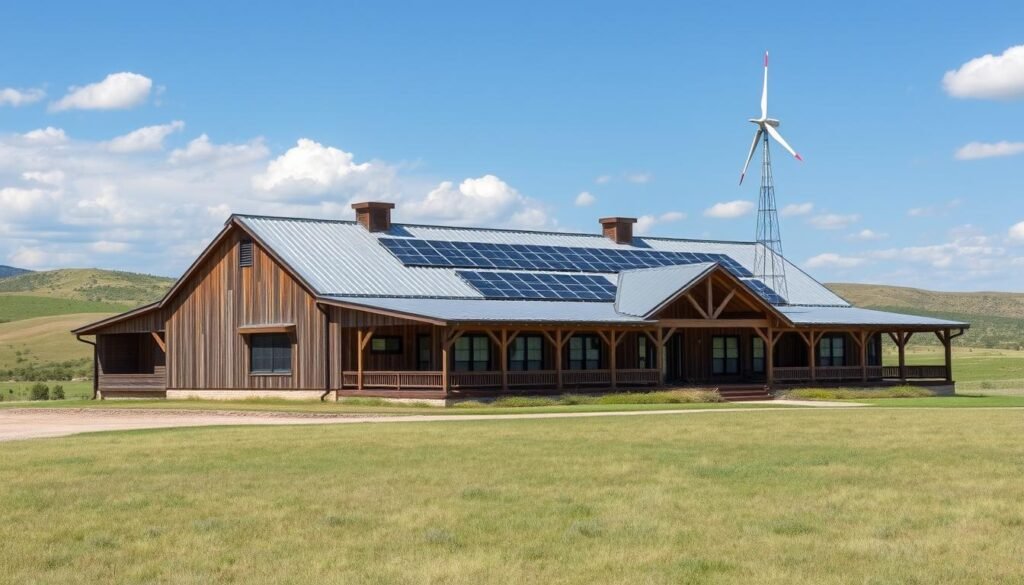
We mix smart systems with durable materials for sustainable design in barndominiums. Owners in Texas save money with efficient buildings. They use less energy thanks to tight seals, high-performance windows, and the right HVAC size.
Small changes, like better insulation, can cut electric bills by 30–50%. This is when paired with efficient equipment.
Energy-Efficient Designs
We size HVAC systems to actual needs, not just estimates. This saves money upfront and over time. It also means lower utility bills.
Passive design helps too. It uses the sun and natural materials to cool homes in Texas’s hot summers.
Renewable systems work well on big roofs of steel Barndominiums. Solar panels, batteries, and net-metering make homes more independent. They also save on utility bills.
Eco-Friendly Materials
Using recycled steel for framing is good for the planet. It lasts longer and can even save on insurance. Reclaimed wood and eco-friendly paints make homes healthier without losing style.
Water is precious, so we use it wisely. Harvesting rainwater and efficient irrigation save water. Permeable paving and careful grading also help manage water.
We suggest using energy-efficient appliances and non-toxic paints. Materials like hempcrete or straw bale are also good choices. For more tips, check out this guide: sustainable design practices.
| Feature | Benefit | Typical Impact |
|---|---|---|
| Insulated metal panels | Lower thermal transfer, quick install | Reduced heating/cooling loads; better Barndominium cost estimates over time |
| Rooftop solar + batteries | Energy independence, backup power | Cuts grid reliance; improves resilience for Texas Barndominiums |
| Recycled steel framing | Durability, lower embodied carbon | Longer service life; lower maintenance for steel Barndominium homes |
| Rainwater harvesting | Water savings for irrigation and non-potable uses | Reduced municipal water demand; better site stewardship |
| Low-VOC finishes | Improved indoor air quality | Healthier living environment; minimal emissions |
Sustainability means long-term savings and a better home. Making smart choices about materials and systems is key. Even small investments can lead to a durable, efficient home that lasts for decades.
Comparing Barndominiums to Traditional Homes
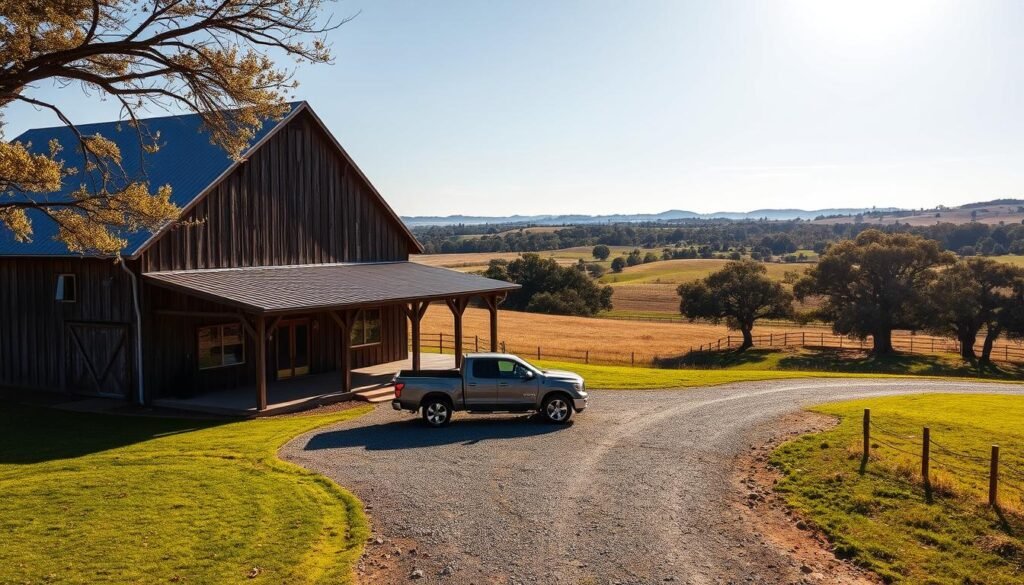
We explore key differences between homes: space, cost, and upkeep. This comparison helps engineers, builders, and buyers understand the trade-offs. It’s about Texas Barndominiums versus traditional stick-built houses.
Space and Layout
Barndos offer large open spaces for easy planning. These spaces allow for flexible layouts, including mezzanines and lofts.
Traditional homes have set rooms and corridors. This means private areas are already defined, making planning easier.
It’s wise to plan Barndominium floor plans early. This ensures quiet bedrooms, efficient workspaces, and strong circulation paths.
Cost Efficiency
Barndominiums are 15–35% cheaper per square foot than traditional homes in 2025. They also have faster construction times. A steel shell can be ready in about four weeks, while traditional framing takes months.
High-end finishes and turnkey packages can close the cost gap. Accurate cost estimates need detailed budgets for finishes, systems, and site work.
Getting multiple quotes is key. Compare shell versus turnkey offers to find real savings.
Maintenance Considerations
Steel exteriors mean less upkeep: no termite damage or rot. They also need less painting, saving on insurance and maintenance costs.
Big open spaces change how you design HVAC. Proper sizing and moisture control are essential to avoid issues.
Resale values for Texas Barndominiums match single-family homes in many areas. They appreciate 3–5% annually. Good marketing and realistic cost estimates boost value.
Use-Case Distinction
- Mixed-use and rural buyers often choose Barndominiums for their speed and flexibility.
- Investors like the quick build and lower costs.
- Dense suburban and urban areas prefer traditional looks and zoning rules.
Testimonials and Case Studies
We collect stories and highlights to show how barndominiums work in real life. You’ll learn about energy, layout, and market appeal from Texas projects. This section combines owner experiences with builder insights to help with future projects.
Stories from Barndominium Owners
Matt started with a weekend retreat that became his main home. He says his electric bills are 30–50% lower than a regular house. His story backs up the industry’s claims about efficient heating and cooling with the right insulation and design.
Many owners start with weekend homes and eventually live there full-time. They use their homes for weekend retreats, live-work studios, shop-house combos, and even short-term rentals. A rural appraiser notes the growing demand for ready-to-move-in, marketable shells.
It’s important to choose builders who know both home finishes and agricultural structures. Builders who use engineered plans and smart insulation tend to do better in the long run.
Successful Projects in Texas
TV shows like Fixer Upper made bold conversions popular. Companies like General Steel and Capital Steel Industries offer quick, flexible solutions. These help speed up construction and reduce waste.
Case studies teach us valuable lessons. Engineered plans, experienced builders, and virtual staging are key. They help luxury Barndominiums sell faster and reduce changes on site.
One example shows how careful planning and a skilled team can make a high-demand rental. They used a steel kit, improved insulation, and professional renderings to get early bookings.
For consultations or to request portfolios from trusted Barndominium builders in Texas, contact info@barndoplans.com or call +1-844-963-9963. Learn more about a detailed client build from Matt at Matt’s Barndominium Building.
Future Trends in Barndominium Construction
Barndominium construction in Texas is set for big changes. New tech, better materials, and what buyers want are all coming together. Prefab steel kits and tighter manufacturing standards are making builds faster.
Photorealistic 3D renderings and virtual staging are helping sell homes before they’re built. They let buyers see finishes before anything is set.
Technological Innovations
Building information modeling (BIM) is now common for customizing kits and finding clashes. This speeds up approvals and cuts down on mistakes. Steel homes are being made with tighter tolerances and modular parts.
Insulated metal panels and recycled steel are making homes more energy-efficient and durable.
Shifts in Consumer Preferences
People want homes that can be used in different ways, like living, working, and shopping. They also want homes that are easy to take care of and save energy. Lenders are more willing to finance prefab steel homes with detailed plans and schedules.
This makes it easier for customers to get financing with Barndominium builders in Texas.
The outlook for investing is good. Faster builds and better costs per square foot are benefits for teams that plan well. For help with design, financing, or quick concept proposals, contact a specialist.
